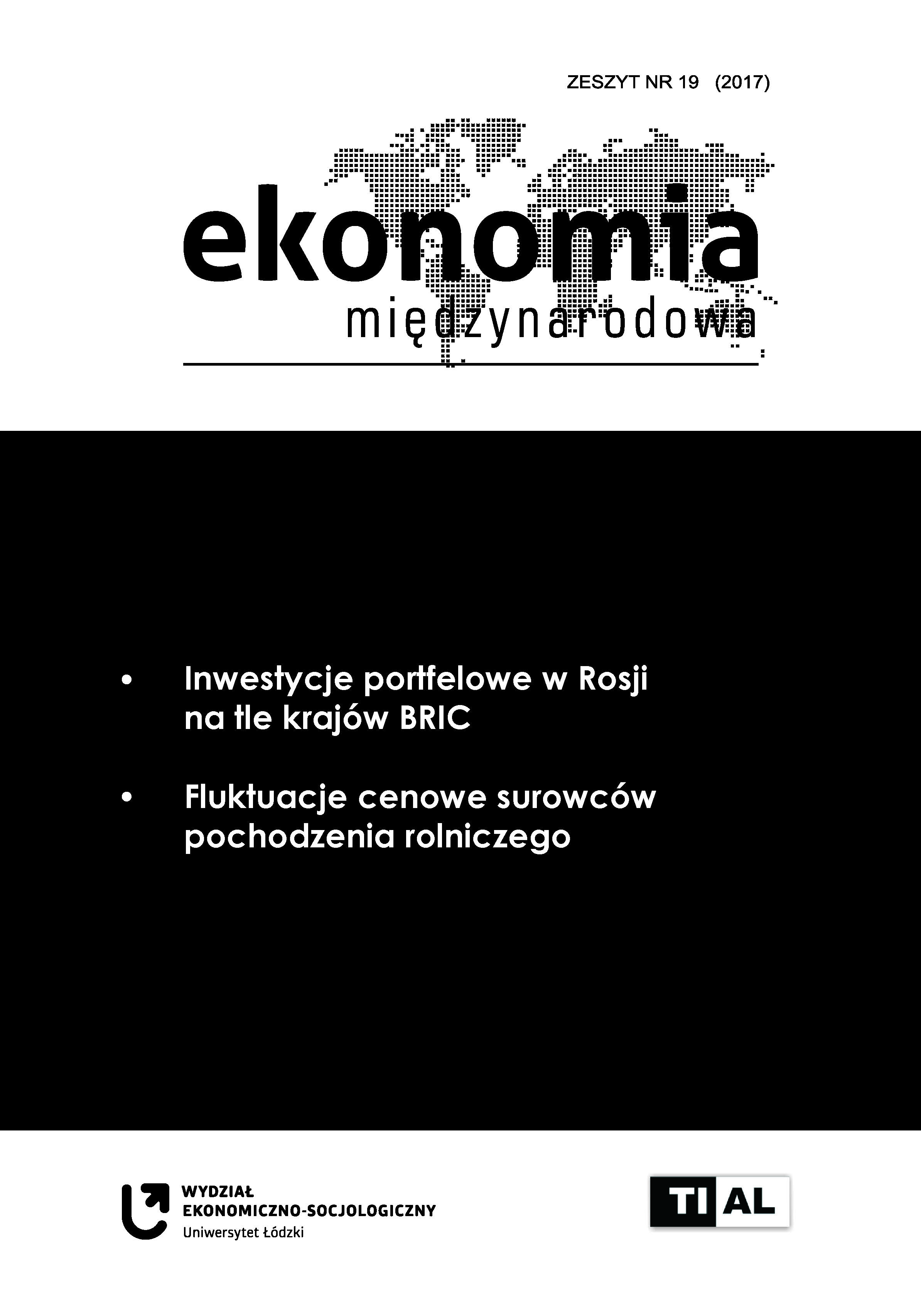Portfolio investment as a factor for the development of the Russian economy as one of the BRIC countries
DOI:
https://doi.org/10.18778/2082-4440.19.01Keywords:
portfolio investment, Russia, international financial flowsAbstract
Portfolio investments have an impact on the development of financial markets around the world, especially in countries of growing importance for the global economy. Russia is one of the countries which are mainly linked to the energy and raw materials sector, so at a time of fluctuations on those markets, its economy is less predictible for international investors.
The regulations for investors in this country (also non-residents) need to be improved to overcome the negative effects of world financial crisises and to rebuild financial markets. Russia is also an economy with large amounts of capital to invest, so it is interesting to observe its financial flows to other countries in the situation when existing regulations are stopping capital for domestic investment.
The following article analyzes the flows of portfolio investment in Russia in the twenty-first century based on balance of payments data in conjunction with changes in the geopolitical situation and the investment attractiveness of the country.
Capital invested in the form of portfolio investments is fragile and often short-term, and it is most vulnerable to periods of recession, causing rapid changes in the flow of this kind of capital. These relationships can be clearly observed in Russia. The strong interest of foreign investors in the Russian economy, in the form of direct and portfolio investments, started in 2000 and lasted until 2006. In the first half of 2008, decreases were slow compared to the record high of the previous year, but from September they accelerated to such an extent that by the end of the year they had reached almost 100%, depicting a sharp decline of foreign investors’ interest in the Russian securities market. This translated into a decline on the Russian stock market. The Russian economy since the beginning of the twenty-first century has experienced a significant influx of foreign capital, including in the form of portfolio investment. However, in comparison with the possibilities of the development of the economic potential of Russia, it is still a small amount.
References
Bożyk P., Misala J., Puławski M. (2002), Międzynarodowe stosunki ekonomiczne, PWE, Warsaw.
Google Scholar
CBRF, External Sector Statistics, The Central Bank of the Russian Federation, http://www.cbr.ru/eng/statistics/?Prtid=svs (accessed: 20 December, 2016).
Google Scholar
CEIC, Foreign Investment Outflow from Russia Headed to Europe, https://www.ceicdata.com/en/blog/foreign-investment-outflow-russia-headed-europe (accessed: 15 December, 2016).
Google Scholar
CPIS (2016), Coordinated Portfolio Investment Survey, International Monetary Fund, http://data.imf.org/?sk=B981B4E3-4E58-467E-9B90-9DE0C3367363&sId=1481577785817 (accessed: 12 December, 2016).
Google Scholar
Doing Business (2016), World Bank, http://data.worldbank.org/data-catalog/doing-business-database (accessed: 15 January, 2017).
Google Scholar
Kłosiński K., Wancio A. (2011), Inwestycje zagraniczne w Rosji, Roczniki Ekonomii i Zarządzania, Vol. 3, No. 39.
Google Scholar
Moscow Exchange – History, https://moex.com/en/Report/2013/history.html (accessed: 16 January, 2017).
Google Scholar
Reilly F. K., Brown K. C. (2011), Investment analysis and portfolio management, Cengage Learning, Boston.
Google Scholar
Rosstat, Russian Federation Federal State Statistic Service, http://www.gks.ru/wps/wcm/connect/rosstat_main/rosstat/en/figures/domestic/ (accessed: 15 December, 2017).
Google Scholar
S&P a, Ratings Direct, http://us.spindices.com/indices/equity/sp-bric-40-index (accessed: 15 December, 2017).
Google Scholar
S&P b, S&P BRIC 40, http://www.fondsprofessionell.de/upload/attach/221920.pdf (accessed: 15 December, 2017).
Google Scholar
S&P c, S&P Dow Jones Indices, http://www.spindices.com/ (accessed: 16 January, 2017).
Google Scholar
Thomson Reuters Datastream, http://financial.thomsonreuters.com/en/products/tools-applications/trading-investment-tools/datastream-macroeconomicanalysis.html (accessed: 21 December, 2017).
Google Scholar
Tikhomirov V. (2000), The Political Economy of Post-Soviet Russia, Palgrave Macmillan UK.
Google Scholar
DOI: https://doi.org/10.1057/9780230289062
Trading Economics, Rosja – Indeks Giełdowy, http://pl.tradingeconomics.com/russia/stock-market (accessed: 21 December, 2017).
Google Scholar
USDS (2014), U.S. Department of State: 2014 Investment Climate Statement, https://www.state.gov/documents/organization/228199.pdf (accessed: 21 December, 2016).
Google Scholar
WB IDS, International Debt Statistics, World Bank, http://data.worldbank.org/indicator/BX.PEF.TOTL.CD.WD?end=2015&start=1960&view=chart&year=2015 (accessed: 21 December, 2017).
Google Scholar
WB WDI, World Development Indicators, World Bank, http://databank.worldbank.org/data/reports.aspx?source=2&series=BN.KLT.PTXL.CD&country (accessed: 17 December, 2017).
Google Scholar
Żukowski M. (2009), Finding the path out of crisis, [in:] Kwaśnik Z., Żukow W., Aktualne wyzwania ekonomii, Radomska Szkoła Wyższa, Radom.
Google Scholar
Downloads
Published
How to Cite
Issue
Section
License

This work is licensed under a Creative Commons Attribution-NonCommercial-NoDerivatives 4.0 International License.









